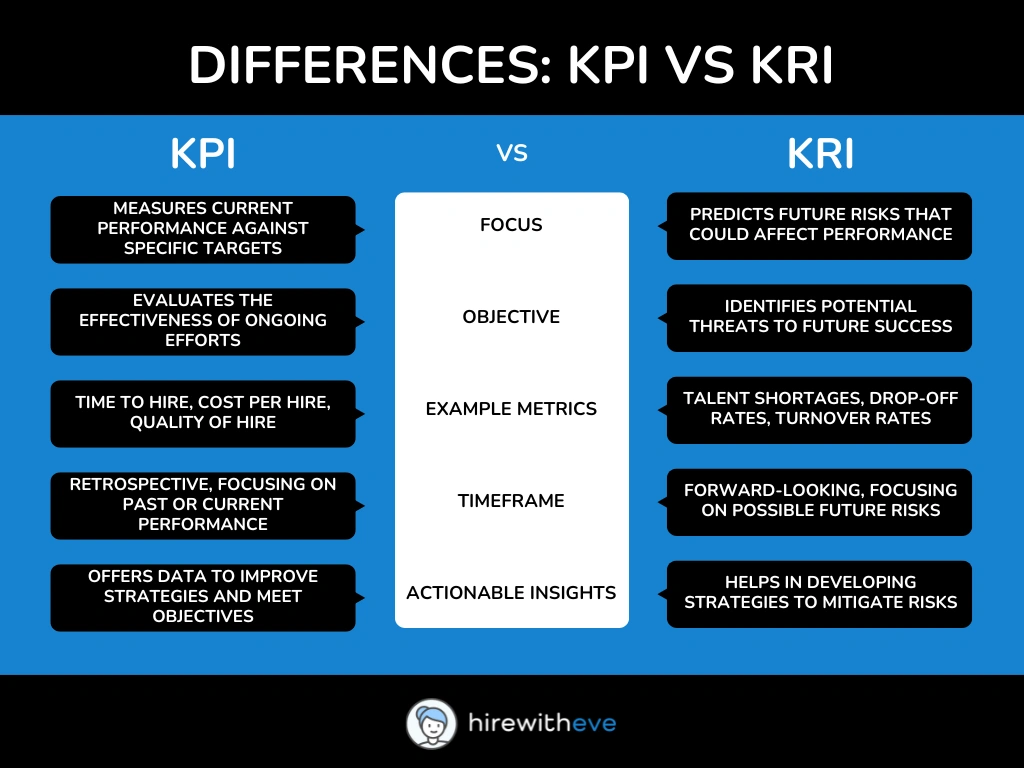KPI vs KRI: What’s the Difference?

In the ever-evolving world of talent acquisition and HR management, measuring performance and risk is crucial for ensuring the success of hiring strategies. As talent acquisition specialists and HR managers, you’re constantly navigating key metrics that help refine your hiring processes.
One critical comparison that often arises is KPI vs KRI. These two metrics, while related, serve different purposes and can dramatically impact your decision-making processes.
When managing a talent acquisition process, measuring both success and potential risks is key. Metrics like KPI vs KRI help provide structure and clarity, allowing HR managers and talent acquisition specialists to track not only how well they are doing but also what risks may be on the horizon.
Though KPIs and KRIs sound similar, they focus on distinct areas — KPIs on performance, and KRIs on risk. Understanding these metrics can transform your talent strategy, helping you make better-informed decisions.
In this blog, we will break down KPI vs KRI, explaining what each term means, how they differ, and why understanding these differences is essential to your role. By the end of this article, you will have a clear understanding of KPI vs KRI, including a detailed comparison to help you apply these concepts in your talent acquisition efforts.
What is KPI?
Key Performance Indicators (KPIs) are quantifiable measures that help HR managers and talent acquisition specialists track the success of their hiring strategies. KPIs are essentially the metrics that show how well a specific objective is being met. In the context of hiring, KPIs can range from tracking the time it takes to fill a role to the quality of hire or the diversity ratio within recruits.
KPIs are all about performance. They give you a snapshot of where your talent acquisition strategy stands and whether your team is meeting its goals. For example:
Time to Hire: The number of days it takes from posting a job to making a hire.
Cost per Hire: How much your company spends on recruitment activities for each hire.
Quality of Hire: A measure of the new hire’s performance, often based on manager feedback and the new hire’s contribution.
These are direct indicators of success, allowing HR teams to adjust their strategies if they fall short of targets. However, KPIs don’t measure risks, which brings us to the other side of the KPI vs KRI conversation.
What is KRI?
Key Risk Indicators (KRIs), on the other hand, focus on identifying potential risks that could derail your talent acquisition strategies. While KPIs measure success, KRIs look ahead to anticipate challenges or risks that could negatively impact your ability to meet your goals.
In talent acquisition, KRIs might include:
Talent Shortages: Indicators showing a declining number of candidates in key roles or industries.
Candidate Drop-off Rates: A measure of the number of potential candidates who leave the hiring process.
Turnover Rates: A sign that internal dissatisfaction may lead to higher attrition, affecting your long-term recruitment needs.
KRIs serve as early warning signals. For instance, if your industry is facing a shortage of skilled professionals, knowing this in advance through KRIs allows you to develop proactive strategies, such as expanding your talent pool or offering more competitive benefits.
While KPIs tell you how well you are currently performing, KRIs help you foresee obstacles that could affect future performance. Now, let’s dive into a direct comparison of KPI vs KRI.
KPI vs KRI: Differences
Understanding the difference between KPI vs KRI is crucial for HR managers and talent acquisition specialists. Here’s a breakdown of their key differences:

As you can see from the table, KPI vs KRI play complementary roles in talent acquisition. KPIs allow you to understand how your efforts are performing right now, while KRIs give you the foresight to anticipate risks and adjust your strategy accordingly.
Conclusion
In the realm of talent acquisition and HR management, KPI vs KRI are critical metrics that together provide a full picture of both performance and risk. KPIs are essential for evaluating how well your strategies are performing, but without KRIs, you could miss potential risks that may hinder future success.
Platforms like HirewithEve.ai play a vital role in making these metrics easier to track and manage. By integrating KPIs and KRIs into one platform, HirewithEve.ai enables talent acquisition specialists to not only measure their current performance but also stay ahead of potential risks. Features like skills-based assessments, remote hiring capabilities, and analytics tools make it easier to understand both the successes and challenges in the hiring process.
Whether you’re trying to reduce your time to hire or anticipate a talent shortage, platforms like HirewithEve.ai give you the data and insights you need. In this way, the comparison between KPI vs KRI becomes a key part of your daily talent acquisition strategy, allowing you to stay proactive and informed.
By understanding KPI vs KRI and utilizing a comprehensive platform like HirewithEve.ai, HR managers can make better decisions that align with both their performance goals and risk management strategies, ensuring long-term success in a competitive job market.





